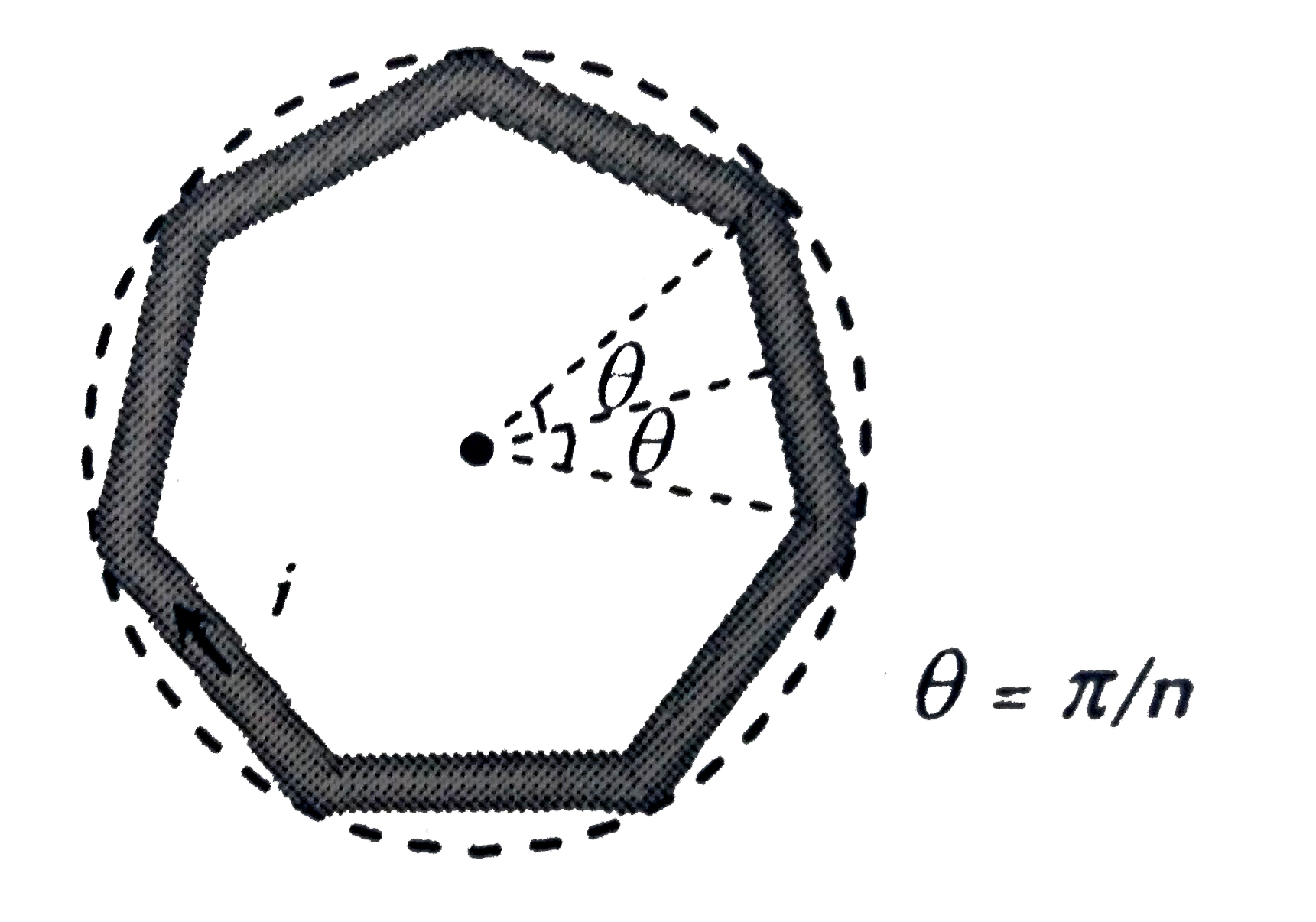A polygon of n sides, inscribed in a circle, is such that its sides subtend angle 2α,4α,…,2nα at the centre of the circles. Prove that its area A1, is to the area A2 of the regular polygon of n iseds inscribed in the same circle, as sinnα:nsinα.
To solve the problem, we need to find the ratio of the area of a polygon with sides subtending angles 2α,4α,…,2nα at the center of a circle to the area of a regular polygon with n sides inscribed in the same circle. Let's denote the area of the first polygon as A1 and the area of the regular polygon as A2.
1. Understanding the Geometry:
- Let the radius of the circle be R.
- The angles subtended by the sides of the polygon at the center are 2α,4α,…,2nα.
2. Finding the Length of Each Side:
- The length of the side corresponding to the angle 2kα (where k=1,2,…,n) can be calculated using the formula:
Length of side=2Rsin(kα)
- Therefore, the lengths of the sides of the polygon are 2Rsin(α),2Rsin(2α),…,2Rsin(nα).
3. Calculating the Area of the Polygon A1:
- The area of a polygon can be expressed as:
A1=12n∑k=1(Length of side)×(Height from center to the side)
- The height from the center to the side corresponding to angle 2kα is Rcos(kα).
- Therefore, the area becomes:
A1=12n∑k=1(2Rsin(kα))(Rcos(kα))=R2n∑k=1sin(kα)cos(kα)
4. Using the Identity:
- We can use the identity sin(kα)cos(kα)=12sin(2kα) to simplify the sum:
A1=R22n∑k=1sin(2kα)
5. Finding the Area of the Regular Polygon A2:
- The area of a regular polygon with n sides inscribed in a circle of radius R is given by:
A2=12nR2sin(2πn)
6. Finding the Ratio A1:A2:
- Now, we can find the ratio of the areas:
A1A2=R2∑nk=1sin(2kα)12nR2sin(2πn)=2∑nk=1sin(2kα)nsin(2πn)
7. Using the Sine Summation Formula:
- The sum n∑k=1sin(2kα) can be simplified using the sine summation formula:
n∑k=1sin(2kα)=sin(nα)sin((n+1)α)sin(α)
8. Final Expression:
- Substituting this back into the ratio gives:
A1A2=2⋅sin(nα)sin((n+1)α)sin(α)nsin(2πn)
9. Conclusion:
- After simplification, we arrive at the final result:
A1:A2=sin(nα):nsin(α)
- Let the radius of the circle be R.
- The angles subtended by the sides of the polygon at the center are 2α,4α,…,2nα.
- The length of the side corresponding to the angle 2kα (where k=1,2,…,n) can be calculated using the formula:
Length of side=2Rsin(kα)
- Therefore, the lengths of the sides of the polygon are 2Rsin(α),2Rsin(2α),…,2Rsin(nα).
- The area of a polygon can be expressed as:
A1=12n∑k=1(Length of side)×(Height from center to the side)
- The height from the center to the side corresponding to angle 2kα is Rcos(kα).
- Therefore, the area becomes:
A1=12n∑k=1(2Rsin(kα))(Rcos(kα))=R2n∑k=1sin(kα)cos(kα)
- We can use the identity sin(kα)cos(kα)=12sin(2kα) to simplify the sum:
A1=R22n∑k=1sin(2kα)
- The area of a regular polygon with n sides inscribed in a circle of radius R is given by:
A2=12nR2sin(2πn)
- Now, we can find the ratio of the areas:
A1A2=R2∑nk=1sin(2kα)12nR2sin(2πn)=2∑nk=1sin(2kα)nsin(2πn)
- The sum n∑k=1sin(2kα) can be simplified using the sine summation formula:
n∑k=1sin(2kα)=sin(nα)sin((n+1)α)sin(α)
- Substituting this back into the ratio gives:
A1A2=2⋅sin(nα)sin((n+1)α)sin(α)nsin(2πn)
- After simplification, we arrive at the final result:
A1:A2=sin(nα):nsin(α)
Topper's Solved these Questions
- PROPERTIES AND SOLUTION OF TRIANGLES BOOK - ARIHANT MATHS ENGLISHCHAPTER - PROPERTIES AND SOLUTION OF TRIANGLES EXERCISE - Exercise (Questions Asked In Previous 13 Years Exam)
21 Videos
- PROPERTIES AND SOLUTION OF TRIANGLES BOOK - ARIHANT MATHS ENGLISHCHAPTER - PROPERTIES AND SOLUTION OF TRIANGLES EXERCISE - Exercise (Subjective Type Questions)
21 Videos
- PRODUCT OF VECTORSBOOK - ARIHANT MATHS ENGLISHCHAPTER - PRODUCT OF VECTORSEXERCISE - Exercise (Questions Asked In Previous 13 Years Exam)
51 Videos
- SEQUENCES AND SERIESBOOK - ARIHANT MATHS ENGLISHCHAPTER - SEQUENCES AND SERIESEXERCISE - Exercise (Questions Asked In Previous 13 Years Exam)
38 Videos
Similar Questions
Given that the area of a polygon of n sides circumscribed about a circle is to the area of the circumscribed polygon of 2n sides as 3:2 find n.
View SolutionIn the following figure a wire bent in the form of a regular polygon of n sides is inscribed in a circle of radius a. Net magnetic field at centre will be

View SolutionIf r is the radius of inscribed circle of a regular polygon of n-sides ,then r is equal to
View SolutionFind the radius of the circumscribing circle of a regular polygon of n sides each of length is a.
View SolutionFind the sum of the radii of the circles, which are respectively inscribed and circumscribed about the a regular polygon of n sides.
View SolutionThe ratio of the area of a regular polygon of n sides inscribed in a circle to that of the polygon of same number of sides circumscribing the same is 3:4. Then the value of n is
View SolutionA polygon of nine sides, each pf length 2, is inscribed in a circle. Prove that the radius of the circle is cosec20∘.
View SolutionIf R is the radius of circumscribing circle of a regular polygon of n-sides,then R =
View SolutionProve that the area of a regular polygon hawing 2n sides, inscribed in a circle, is the geometric mean of the areas of the inscribed and circumscribed polygons of n sides.
View SolutionThe side of a triangle inscribed in a given circle subtends angles α,βandγ at the centre. The minimum value of the arithmetic mean of cos(α+π2),cos(β+π2) , and cos(γ+π2) is equal to ____
View Solution
